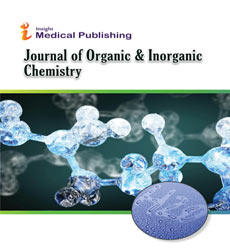Green Chemistry in Action: Bridging Education and Sustainable Development Goals
Fahd Nasir
Department Quality Assurance and Pharmaceutics, Najran University, Najran, Saudi Arabia
Published Date: 2024-12-16DOIDepartment Quality Assurance and Pharmaceutics, Najran University, Najran, Saudi Arabia
Fahd Nasir*
1Department Quality Assurance and Pharmaceutics, Najran University, Najran, Saudi Arabia
- *Corresponding Author:
- Fahd Nasir,
Department Quality Assurance and Pharmaceutics, Najran University, Najran, Saudi Arabia
E-mail: nasirfahd@na.su
Received date: November 30, 2024, Manuscript No. IPJOIC-24-20053; Editor assigned date: December 02, 2024, PreQC No. IPJOIC-24-20053 (PQ); Reviewed date: December 16, 2024, QC No. IPJOIC-24-20053; Revised date: December 23, 2024, Manuscript No. IPJOIC-24-20053 (R); Published date: December 30, 2024, DOI: 10.36648/2472-1123.10.4.103
Citation: Nasir F (2024) Green Chemistry in Action: Bridging Education and Sustainable Development Goals. J Org Inorg Chem Vol.10 No.4: 103.
Description
Green chemistry education has seen remarkable growth, emphasizing the integration of sustainable practices into chemical education. Central to this is the teaching of the 12 principles of green chemistry, which aim to minimize waste, utilize atom economy, avoid hazardous substances and prioritize safer solvents and renewable resources. This educational approach equips students with a systems-thinking perspective, enabling them to design sustainable and environmentally friendly chemical processes. Incorporating green chemistry into laboratory curricula fosters critical thinking about the societal and environmental impacts of chemicals. This not only inspires innovative solutions in waste reduction and pollution prevention but also aligns with the United Nations Sustainable Development Goals (SDGs). Goals such as Goal 12: Responsible Consumption and Production and Goal 6: Clean Water and Sanitation are directly addressed by teaching student’s sustainable practices, particularly in relation to commonly used substances like surfactants.
Challenges in traditional catalyst preparation
Among the conventional techniques, impregnation methods are widely used for fabricating supported catalysts. These methods involve either impregnating a mixed precursor solution onto a support or performing sequential impregnation of individual precursors. The subsequent drying and calcination steps convert the precursors into active metal oxide phases. However, these processes often lead to complications, such as the formation of complex metal oxide alloys that are difficult to reduce or the generation of isolated particles rather than bimetallic interfaces. Factors such as the support's surface properties, hydrophilicity and isoelectric point significantly influence the size, distribution and interaction of the active components.
Surfactants: Applications and environmental concerns
Surfactants are amphiphilic molecules that lower surface tension at interfaces, making them indispensable in a wide range of applications, including pharmaceuticals, textiles, personal care and detergents. Their global market, valued at approximately $42.1 billion, highlights their economic significance. However, their extensive use raises critical environmental concerns. Surfactants often persist in wastewater, challenging water treatment systems and contributing to water pollution. Their release into aquatic environments can harm ecosystems and disrupt biodiversity, posing risks to the achievement of Goal 14: Life Below Water. Addressing these challenges necessitates advancing sustainable production and effective wastewater treatment technologies, aligning with SDGs. The soapnut tree (Sapindus mukorossi), indigenous to India and parts of Asia, offers a sustainable alternative to synthetic surfactants. Soapnut fruits contain saponins, natural surfactants with biodegradable properties, traditionally used for cleaning and medicinal purposes. Saponins, classified as neutral surfactants, consist of sugar molecules (hydrophilic) and steroid or triterpenoid structures (hydrophobic). Historically, soapnut fruits have served as detergents, producing lather similar to synthetic soaps. Their use promotes sustainable surfactant production due to biodegradable characteristics and eco-friendly harvesting methods. Integrating soapnut-based products into modern applications aligns with green chemistry principles, contributing to sustainable development by reducing environmental impact.
Connecting surfactants to sustainability goals
The transition to greener surfactants like soapnut aligns with multiple SDGs:
Goal 6: Clean Water and Sanitation-Mitigating water pollution through the use of biodegradable surfactants.
Goal 14: Life Below Water-Protecting aquatic ecosystems by minimizing harmful surfactant contamination.
Goal 12: Responsible Consumption and Production-Encouraging sustainable alternatives to synthetic chemicals.
Conclusion
Educating students on green chemistry and sustainable alternatives like soapnut empowers them to address global environmental challenges. By integrating these principles into practical applications, future chemists are better equipped to advance sustainable practices, ensuring a positive impact on society and the environment. This approach not only contributes to achieving SDGs but also fosters innovation in green chemistry and sustainable industrial practices.
Open Access Journals
- Aquaculture & Veterinary Science
- Chemistry & Chemical Sciences
- Clinical Sciences
- Engineering
- General Science
- Genetics & Molecular Biology
- Health Care & Nursing
- Immunology & Microbiology
- Materials Science
- Mathematics & Physics
- Medical Sciences
- Neurology & Psychiatry
- Oncology & Cancer Science
- Pharmaceutical Sciences
